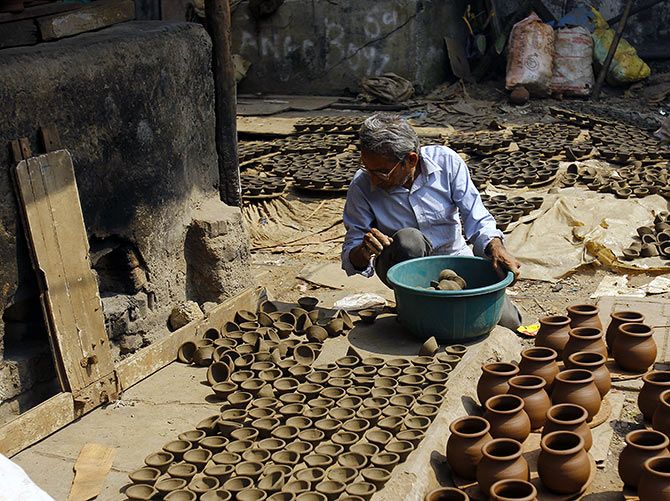 Tista Sengupta takes a walk through Kumbharwada, north Mumbai's potters’ colony, and discovers that kumbhars struggle to keep the traditional art of clay diya making alive. Photographs: Hitesh Harisinghani
Tista Sengupta takes a walk through Kumbharwada, north Mumbai's potters’ colony, and discovers that kumbhars struggle to keep the traditional art of clay diya making alive. Photographs: Hitesh Harisinghani
The mud-splattered wheel lies silent.
Then, footsteps.
A lump of clay is slapped onto the centre of the waiting wheel.
A flick of the hand, an expert turn of the wheel and delicate fingers magically transform the clay into vases, pots, pans, matkis (vessels used to store water), kullars (disposable tea containers) and, during Diwali, into beautiful diyas (lamps).
This, for nearly hundred years, has been a way of life at Kumbharwada (literally translated from Marathi, this means potters’s colony).
Located in Dharavi, in the heart of India’s financial capital, Mumbai, these potters are today struggling to keep their traditional art form alive as they battle the cheap China-made products that flood the market during the festive season.
During Diwali -- a festival they look forward too for many reasons, including the fact that this was when they made more money -- this colony would be buzzing with activity.
It still does, only now they cannot be sure of their hard work will earn them enough money so that they too can celebrate the Festival of Lights.

This is what you will see across the meandering alleys of Kumbharwada if you walk through it today... baskets of different kinds of diyas ready for the market.
Suddenly, a man caught our attention.

Body drenched in sweat, he was stomping non-stop on clay.
A native of Uttar Pradesh, this 61-year-old comes to Mumbai every year during the Diwali season to mix the clay that the potters will use to create their diyas.
We ask him his name. "I have no name," he says. "No caste. No religion."

He mixes two kinds of clay -- red clay from Gujarat and normal clay from Nasik-- with his feet until they form a fine dough.
"Mixing the clay well is very important, else the diyas won't get proper shape. I have been doing this for the past 30 years. My work starts at 9 am and I earn Rs 500 everyday," he says, as his feet continue to stomp on the clay.

A little ahead, Hasmukh is sitting in his house, before a spinning wheel, giving shape to the clay.
In a day, he makes around 2,000 diyas. Each batch of 1,000 diyas sells for Rs 800 in the wholesale market; not enough for him to make a profit.
Then, there is the ongoing battle against the glittery commercially-produced diyas which are edging the traditionally made ones out of the market.

Ahead, another potter was drying his diyas under the bright sun.

As we walked past him, we saw something that one normally does not think one would see in a city. A brick kiln.
Once the diyas are dry, explains Maru Manji who is preparing to fire the next batch of diyas, they are hardened in the heat of the kiln for almost three to four hours.
Maru says he has been doing this since he was 10 years old.

Unlike the traditional diyas, the coloured ones are more in demand in the market these days.
The responsibility of colouring and packaging the diyas lies with the women.

Ramila Devalia, 46, has been working day and night at this task since Navratri.
She has completed 27,000 diyas already this year :)
Ironically, the local shopkeepers don't buy diyas from these potters. They bring them in from Gujarat.

Hasmukh Parmar was sitting outside his house, applying another coat of colour on the diyas to make them look brighter.
"Madam," he grins, "zamaana disco wala hai (people like bright, flashy designs)."
According to him, the potters in Kumbharwada usually make clay diyas which people aren't interested in any more so, he has to get his diyas from elsewhere.

Once the colouring is complete, the women pour liquid wax into the diyas.

Finally, they are ready to be packed and sent to the market.
Which is where we are right now. And yes, Diwali shopping is full swing.
Everyone wants to brighten their homes with colourful diyas.

Sadly, though, in all that excitement, no one seems to notice this woman with a mound of traditionally made diyas for sale.
Photographs: Hitesh Harisinghani/Rediff.com










